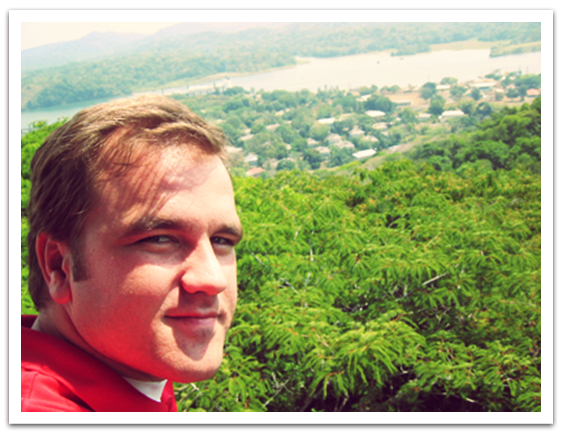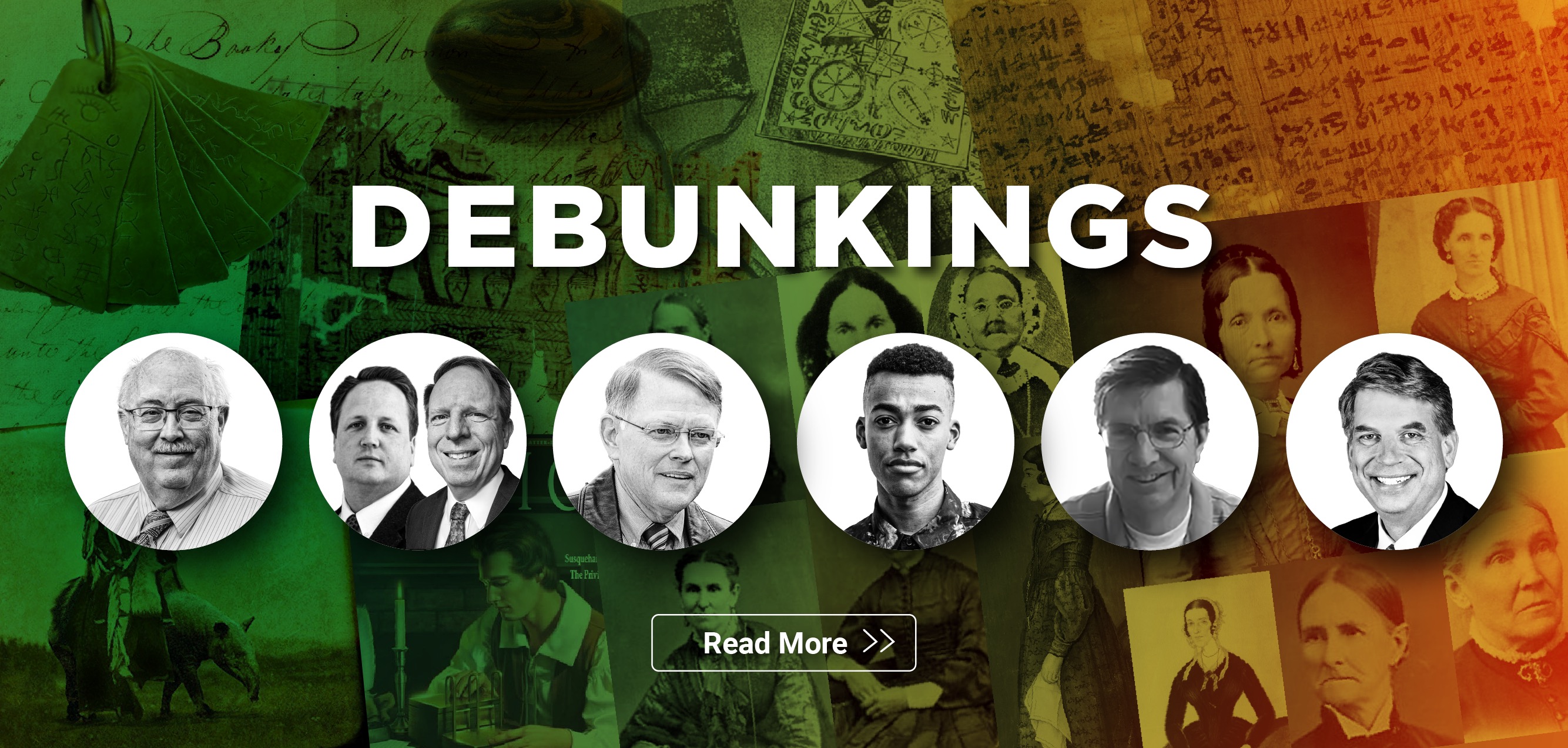Detailed Response
First Vision
- "I am not worried that the Prophet Joseph Smith gave a number of versions of the First Vision anymore than I am worried that there are four different writers of the gospels in the New Testament, each with his own perceptions, each telling the events to meet his own purpose for writing at the time. I am more concerned with the fact that God has revealed in this dispensation a great and marvelous and beautiful plan that motivates men and women to love their Creator and their Redeemer, to appreciate and serve one another, to walk in faith on the road that leads to immortality and eternal life.”
– Gordon B. Hinckley, "God Hath Not Given Us the Spirit of Fear”, Ensign, Oct. 1984.
FairMormon deleted their above response. See screenshot.
Jeremy's Response to FairMormon
I find a number of problems with Gordon B. Hinckley's analogy.
The first problem is that the gospels were written by four separate individuals telling their own perspectives, while Joseph Smith is one individual giving four separate accounts on separate occasions. If the four gospels we have today in the New Testament were instead all written by one person giving four separate accounts, then this comparison would be better suited.
The second, and perhaps even more important, problem is that the accounts of the four different individuals – Matthew, Mark, Luke, John – were far more consistent than Joseph Smith was in his four separate accounts. Joseph contradicted himself on key details about the most important event in his life: a personal visit from God.
There are at least 4 different First Vision accounts by Joseph Smith
"There are at least 4 different First Vision accounts by Joseph Smith."
- Correct:
There are more than four. The Church website "lds.org” describes four main accounts and a number of second hand accounts, and links to the original documents on the Joseph Smith Papers website. - FairMormon then posts an extract from the Church's new "First Vision Accounts” essay that the Church published recently in November 2013:
"The various accounts of the First Vision tell a consistent story, though naturally they differ in emphasis and detail. Historians expect that when an individual retells an experience in multiple settings to different audiences over many years, each account will emphasize various aspects of the experience and contain unique details. Indeed, differences similar to those in the First Vision accounts exist in the multiple scriptural accounts of Paul's vision on the road to Damascus and the Apostles' experience on the Mount of Transfiguration.3 Yet despite the differences, a basic consistency remains across all the accounts of the First Vision. Some have mistakenly argued that any variation in the retelling of the story is evidence of fabrication. To the contrary, the rich historical record enables us to learn more about this remarkable event than we could if it were less well documented.”
1832 Account. The earliest known account of the First Vision, the only account written in Joseph Smith's own hand, is found in a short, unpublished autobiography Joseph Smith produced in the second half of 1832. In the account, Joseph Smith described his consciousness of his own sins and his frustration at being unable to find a church that matched the one he had read about in the New Testament and that would lead him to redemption. He emphasized Jesus Christ's Atonement and the personal redemption it offered. He wrote that "the Lord” appeared and forgave him of his sins. As a result of the vision, Joseph experienced joy and love, though, as he noted, he could find no one who believed his account. Read the 1832 account here.
1835 Account. In the fall of 1835, Joseph Smith recounted his First Vision to Robert Matthews, a visitor to Kirtland, Ohio. The retelling, recorded in Joseph's journal by his scribe Warren Parrish, emphasizes his attempt to discover which church was right, the opposition he felt as he prayed, and the appearance of one divine personage who was followed shortly by another. This account also notes the appearance of angels in the vision. Read the 1835 account here.
1838 Account. The narration of the First Vision best known to Latter-day Saints today is the 1838 account. First published in 1842 in the Times and Seasons, the Church's newspaper in Nauvoo, Illinois, the account was part of a longer history dictated by Joseph Smith between periods of intense opposition. Whereas the 1832 account emphasizes the more personal story of Joseph Smith as a young man seeking forgiveness, the 1838 account focuses on the vision as the beginning of the "rise and progress of the Church.” Like the 1835 account, the central question of the narrative is which church is right. Read the 1838 account here.
1842 Account. Written in response to Chicago Democrat editor John Wentworth's request for information about the Latter-day Saints, this account was printed in the Times and Seasons in 1842. (The "Wentworth letter,” as it is commonly known, is also the source for the Articles of Faith.)4 The account, intended for publication to an audience unfamiliar with Mormon beliefs, is concise and straightforward. As with earlier accounts, Joseph Smith noted the confusion he experienced and the appearance of two personages in answer to his prayer. The following year, Joseph Smith sent this account with minor modifications to a historian named Israel Daniel Rupp, who published it as a chapter in his book, He Pasa Ekklesia [The Whole Church]: An Original History of the Religious Denominations at Present Existing in the United States. Read the 1842 account here.
Secondhand Accounts. Besides these accounts from Joseph Smith himself, five accounts were written by contemporaries who heard Joseph Smith speak about the vision. Read these accounts here.
FairMormon deleted their above response. See screenshot.
Jeremy's Response to FairMormon
Although I realize there are more than four First Vision accounts, I'm concerned with the four main accounts, which I discussed in the CES Letter (1832, two 1835, and 1838 accounts). These accounts conflict with each other, whereas after the 1838 account (which itself was written 18 years and published 22 years after the First Vision supposedly occurred), Joseph appeared to have kept his story straight.
The Church response that FairMormon points out is a new essay the Church published on its website on November 20, 2013 entitled "First Vision Accounts.”
"The various accounts of the First Vision tell a consistent story, though naturally they differ in emphasis and detail. Historians expect that when an individual retells an experience in multiple settings to different audiences over many years, each account will emphasize various aspects of the experience and contain unique details. Indeed, differences similar to those in the First Vision accounts exist in the multiple scriptural accounts of Paul's vision on the road to Damascus and the Apostles' experience on the Mount of Transfiguration. Yet despite the differences, a basic consistency remains across all the accounts of the First Vision. Some have mistakenly argued that any variation in the retelling of the story is evidence of fabrication. To the contrary, the rich historical record enables us to learn more about this remarkable event than we could if it were less well documented.”
Contrary to this statement, the various accounts of the First Vision absolutely do not tell a consistent story. They tell an inconsistent one. The Church's "though naturally they differ in emphasis and detail” claim is understating it, to say the least.
One example of contradiction is as follows:
1832 handwritten account by Joseph Smith:


Official 1838 First Vision account:

I address additional inconsistencies and contradictions of the various First Vision accounts below.
"Some have mistakenly argued that any variation in the retelling of the story is evidence of fabrication. To the contrary, the rich historical record enables us to learn more about this remarkable event than we could if it were less well documented.”
This statement turns logic on its head. Although some minor variation in the retelling of a story may not necessarily be evidence of fabrication, key inconsistencies are precisely what investigators and cross-examining attorneys look for to establish whether a person is telling the truth. The Church's "[t]o the contrary” preface in the second sentence above implies that the more variation in a story, the better. That notion is nonsensical.
"The dates / his ages are all over the place”
The letter uses some highly unreliable data from the critical website "mormoninfographics" to illustrate differences in the First Vision accounts. The author uses this data to support his assertion that Joseph's age was "all over the place" in his various accounts.
- Incorrect:
The ages are not "all over the place." - The only account produced by Joseph Smith that indicated a different age was the 1832 account (age 15 rather than 14, based upon a text insertion above the line by Frederick G. Williams after Joseph had already written his account). All remaining accounts indicate age 14 (the "15th” year).
- In the 1832 account, Frederick G. Williams inserted the "in the 16th year of my age” above Joseph's text after Joseph had already written it. (See: "History, circa Summer 1832,” The Joseph Smith Papers)

- Since this was posted, the owner of "mormoninfographics" acknowledged and corrected this mistake by removing all of the ages from this particular graphic: "I am the owner and main contributor to mormoninfographics.com I wanted to thank you or whoever for pointing out the error I had in the 1835 Jewish Minister account. I had mistakenly labeled his age as 17. This has since been corrected. I apologize for the error and welcome any and all input on this or any other infographic. Thank you." (Posted by bjpascoal, on 20 June 2013 - 08:35 PM on Mormon Dialogue and Discussion Board) off-site The author of "Letter to a CES Director" subsequently corrected the graphic in the copy of the letter hosted on his site.

FairMormon deleted their above response. See screenshot.
Jeremy's Response to FairMormon
As FairMormon mentioned above, MormonInfographics and I quickly corrected the mistake when FairMormon brought it to our attention. I have inserted the corrected infographic into the updated CES Letter. Additionally, I have rephrased the wording in the CES Letter to:
The dates / his ages: The 1832 account states Joseph was 15 years old when he had the vision in 1821 while the other accounts state he was 14 years old in 1820 when he had the vision.
Joseph's 1832 account states that he was 15-years-old (1821) when he received the vision. The other accounts state that he was 14-years-old (1820). The discrepancy of the dates/ages still stands.
The reason or motive for seeking divine help…are all over the place
"The reason or motive for seeking divine help – bible reading and conviction of sins, a revival, a desire to know if God exists, wanting to know which church to join – are all over the place."
- Incorrect:
Joseph's motivations for praying are not "all over the place.” He had two motivations: forgiveness of sins, and a desire to know which church was right. - 1832 Account -
my intimate acquaintance with those of different denominations, led me to marvel exceedingly. For I discovered that they did not adorn their profession by a holy walk and godly conversation agreeable to what I found contained in that sacred depository. This was a grief to my soul…
My mind became exceedingly distressed for I became convicted of my sins…He spake unto me saying, 'Joseph my son, they sins are forgiven thee.' - 1835 Account (9 Nov. 1835)
Being wrought up in my mind, respecting the subject of religion and looking at the different systems taught the children of men, I knew not who was right or who was wrong and I considered it of the first importance that I should be right…
He said unto me thy sins are forgiven thee… - 1835 Account (14 Nov. 1835) –
This account is simply a one line summary of the vision – motive not given. - 1838 Account (published in 1842) –
Who of all these parties are right; or, are they all wrong together? If any one of them be right, which is it, and how shall I know it?...My object in going to enquire of the Lord was to know which of all the sects was right, that I might know which to join…
Many other things did He say unto me which I cannot write at this time… - 1840 Account by Orson Pratt –
…if any of these denominations be the Church of Christ, which one is it?...
He was informed that his sins were forgiven.
FairMormon deleted their above response. See screenshot.
Jeremy's Response to FairMormon
I admit that my phrase "all over the place" was hyperbolic. I have rephrased the wording in the updated CES Letter as follows:
The reason or motive for seeking help – Bible reading and conviction of sins, a revival, a desire to know if God exists, wanting to know which Church to join – are not reported the same in each account.
Who appears to him – a Spirit, an angel, two angels, Jesus,
many angels, the Father and the Son – are all over the place.
The graphic indicates that the reference in the second 1835 account of a "visitation of Angels" is somehow distinct from the detailed account of seeing "two personages" in the first 1835 account, which was written only five days earlier.
- The account that Joseph wrote in his journal on 9 November 1835 was a detailed account.
- The account that Joseph wrote five days later in his journal on 14 November 1835 was a one line summary of the event: "the first visitation of Angels.”
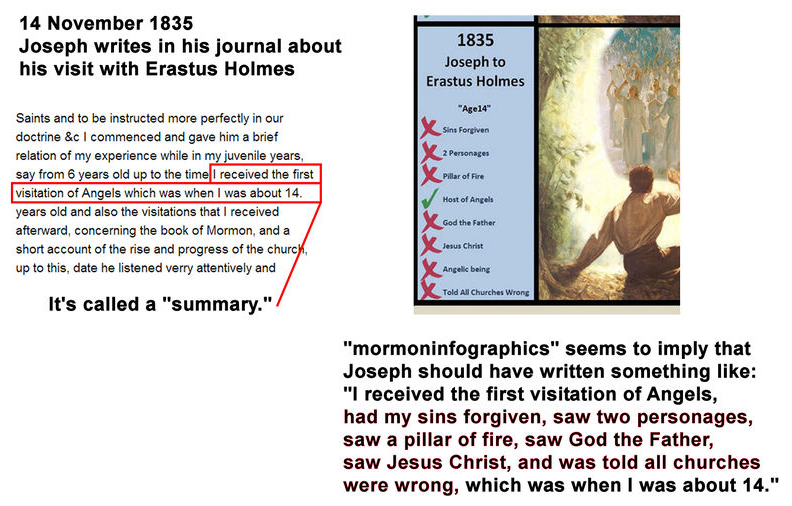
FairMormon deleted their above response. See screenshot.
Jeremy's Response to FairMormon
Note that FairMormon does not dispute my statement from the CES Letter:
Who appears to him – a spirit, an angel, two angels, Jesus, many angels, the Father and the Son – are all over the place.
I am not just referring to the 1835 accounts. I am referring to the various accounts as a whole. When the accounts are viewed combined, it becomes obvious that who Joseph states visited him is inconsistent.
By the way, this 1835 account was falsified into the History of the Church (Vol. 2, Ch. 23, p.312). Despite correctly being published in the Church newspaper (Deseret News, Vol.2, No. 15, Saturday, May 29, 1852) as specifically including Joseph's words, "I received the first visitation of Angels,” the Church altered Joseph's words to instead read "I received my First Vision…” in the History of the Church.
Below are screenshots:
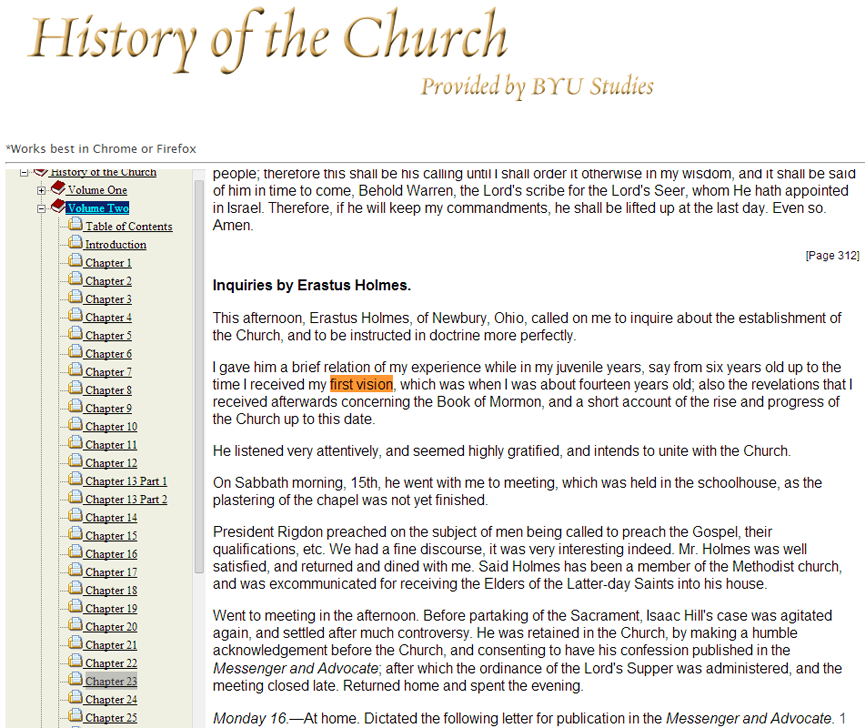
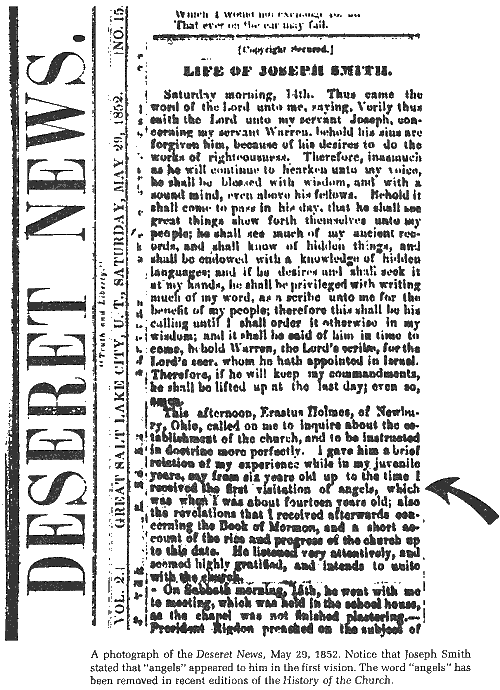
This was done in order to make it consistent with the later, more dynamic idea the First Vision ultimately became, which was not to be one of angels as Joseph had earlier claimed, but that of both the Father and the Son.
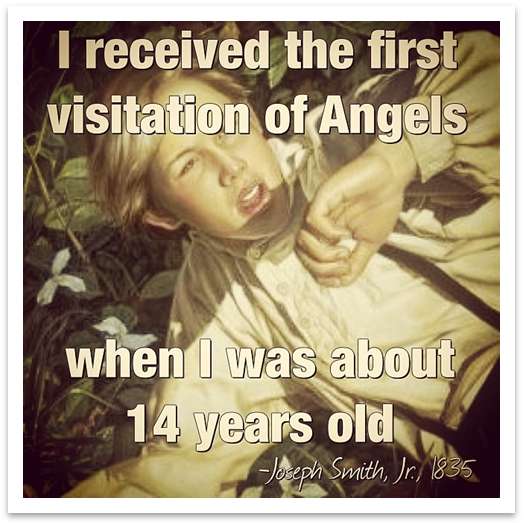
The historical record shows that there was no revival in Palmyra in 1820
"The historical record shows that there was no revival in Palmyra in 1820. There was one in 1817 and there was another in 1824. There are records from his brother, William Smith, and his mother Lucy Mack Smith, both stating that the family joined Presbyterianism after Alvin's death in November 1823 despite Joseph Smith claiming in the official 1838 account that they joined in 1820; 3 years before Alvin Smith's death."
- Correct:
It is correct that there were two large revivals in the Palmyra area, one in 1816-1817 and the other in 1824-1825. - Joseph never calls the excitement concerning religion a "revival” in any of his First Vision accounts.
- Joseph's concern about religion started when he was twelve years old, close on the heels of the revival of 1817. In his 1832 account, Joseph notes that his concern about religion began at age 12 (1817-1818):
"At about the age of twelve years my mind become seriously imprest with regard to the all importent concerns of for the wellfare of my immortal Soul which led me to searching the scriptures believeing as I was taught, that they contained the word of God thus applying myself to them and my intimate acquaintance with those of different denominations led me to marvel excedingly for I discovered that they did not adorn instead of adorning their profession by a holy walk and Godly conversation agreeable to what I found contained in that sacred depository this was a grief to my Soul...” (Joseph Smith's 1832 account of the First Vision) - Richard Bushman notes that this "would have been in late 1817 and early 1818, when the after-affects of the revival of 1816 and 1817 were still felt in Palmyra.
- Joseph Smith talked of observing, as a 14-year-old, "an unusual excitement on the subject of religion" in the Palmyra area during the Spring of 1820. Joseph notes that "It commenced with the Methodists, but soon became general among all the sects in that region of country." There is documented evidence of at least one Methodist camp meeting in the Palmyra area during that period, which only by chance happened to be mentioned in the local newspaper because of a specific death that seemed to be associated with it. In addition, there are newspaper articles talking of large-scale revival activity in the larger region surrounding Palmyra during the same general period when Joseph Smith said that it was taking place.
- It is reasonable to assume based upon the facts that the Methodists had more than one camp meeting during this period. This could easily account for the religious excitement in Palmyra that, in Joseph's mind at age 14, began with the Methodists.
FairMormon deleted their above response. See screenshot.
Jeremy's Response to FairMormon
This is FairMormon trying to fit a square peg in a round hole. FairMormon is engaging in some historical revisionism by reducing Joseph's experience to a Methodist camp meeting, which they bizarrely claim "easily account[s] for the religious excitement...in Joseph's mind at 14...."
Let's have Joseph tell us about his claimed experience that took place in Palmyra, New York:
There was in the place where we lived an unusual excitement on the subject of religions. It commenced with the Methodist, but soon became general among all the sects in that region [Palmyra] of the country...great multitudes united themselves to the different religious parties, which created no small stir...Some were contending for the Methodist faith, some for the Presbyterian, and some for the Baptist. – Joseph Smith History 1:5
The fact that FairMormon and apologists have to do everything they can to stretch the 1817-1818 Revival as long as possible - all the way into 1820 - as Joseph claimed, is a testament in itself that there was no revival environment in 1820 as Joseph described and claimed in his history.
Again, Joseph's mother, Lucy, and Joseph's brother, William, both stated that the family joined Presbyterianism after Alvin's death in November 1823. The historical record is consistent with Lucy and William's claim as there was an 1824-1825 revival after Alvin's death in 1823.
Why did Joseph Smith claim in his 1838 account they joined in 1820? When there was no revival? When it was 3 years before Alvin Smith's death, as stated by Joseph's mother and brother?
Why did Joseph hold a Trinitarian view of the Godhead
if he clearly saw that
the Father and Son were separate embodied beings
in the official First Vision?
"Why did Joseph hold a Trinitarian view of the Godhead, as shown previously with the Book of Mormon, if he clearly saw that the Father and Son were separate embodied beings in the official First Vision?" The author also notes that not all instances were changed, and that "The following verses are among many verses still in the Book of Mormon that hold a Trinitarian view of the Godhead..."
- The earliest edition of the Book of Mormon referred to Jesus as "God," but in later editions some, but not all, of these references were changed to "the Son of God." They claim Joseph was originally a solid Trinitarian (perhaps even a Modalist), and as he later began to teach that the Father and Son were two separate beings, he had to change the Book of Mormon to support his new doctrine.
FairMormon deleted their above response. See screenshot.
Jeremy's Response to FairMormon
"Joseph was originally a solid Trinitarian (perhaps even a Modalist), and as he later began to teach that the Father and Son were two separate beings, he had to change the Book of Mormon to support his new doctrine."
This is exactly what I'm claiming. The historical evidence shows that Joseph Smith’s view of the Godhead evolved and changed in the late 1820s to the late 1830s. The details of this modalism is explained in The Book of Mormon taught and still teaches a Trinitarian view of the Godhead.
This is problematic due to Joseph’s claim in his 1838 First Vision account, which the LDS Church has used and taught and still is using and teaching, that Joseph saw and learned that the Father and the Son are two separate embodied Beings.
Notice that FairMormon does not dispute or deny that Joseph was Trinitarian in his views of God.
FairMormon deleted the following FairMormon response on July 28, 2013:
“Joseph and the early Saints were not trinitarian, and understood God's embodiment and the identity of the Father and Son as separate beings very early on. This doctrine is apparent in the Book of Mormon, and in the earliest friendly and non-friendly accounts of such matters from the Saints. Such texts demonstrate that the supposed 'evidence' for Joseph altering his story later is only in the eyes of critical beholders.”
Very strong wording and denial there. Why did FairMormon delete their above response?
- The second edition of the Book of Mormon was published in 1837 at Kirtland, Ohio. The typesetting and printing were done during the winter of 1836–37, with Joseph Smith and Oliver Cowdery taking an active part in the editing process. In this edition numerous corrections were made to the text of the 1830 (first) edition to bring it back to the reading in the original and printer's manuscripts. Joseph Smith also made a number of editorial changes to the text. Among the changes he made are these four in 1 Nephi 11 and 13:
FairMormon deleted their above response. See screenshot.
Jeremy's Response to FairMormon
"In this edition numerous corrections were made to the text of the 1830 (first) edition to bring it back to the reading in the original and printer's manuscripts."
This is a deceptive statement. A quick overview of the Book of Mormon production process from LDS Royal Skousen is in order:
The printed versions of the Book of Mormon derive from two manuscripts. The first, called the original manuscript (O), was written by at least three scribes as Joseph Smith translated and dictated. The most important scribe was Oliver Cowdery. This manuscript was begun no later than April 1829 and finished in June 1829.
A copy of the original was then made by Oliver Cowdery and two other scribes. This copy is called the printer's manuscript (P), since it was the one normally used to set the type for the first (1830) edition of the Book of Mormon. It was begun in July 1829 and finished early in 1830.
The printer's manuscript is not an exact copy of the original manuscript. There are on the average three changes per original manuscript page. These changes appear to be natural scribal errors; there is little or no evidence of conscious editing. Most of the changes are minor, and about one in five produce a discernible difference in meaning. Because they were all relatively minor, most of the errors thus introduced into the text have remained in the printed editions of the Book of Mormon and have not been detected and corrected except by reference to the original manuscript. About twenty of these errors were corrected in the 1981 edition.
The compositor for the 1830 edition added punctuation, paragraphing, and other printing marks to about one-third of the pages of the printer's manuscript. These same marks appear on one fragment of the original, indicating that it was used at least once in typesetting the 1830 edition.
In preparation for the second (1837) edition, hundreds of grammatical changes and a few textual emendations were made in P [Printer’s Manuscript].
Here is FairMormon’s chart again showing the Original Manuscript, Printer’s Manuscript, 1830 edition, and 1837 edition:
Click on graphic to expand:
Notice the strikeouts and <insertions> in the Printer’s Manuscript. These strikeouts and <insertions> were added by Joseph in 1837 in preparation of the 1837 edition. FairMormon acknowledges this on the bottom of the chart.
Therefore, FairMormon’s “in this edition numerous corrections were made to the text of the 1830 (first) edition to bring it back to the reading in the original and printer's manuscripts” wording and claim is deceptive and false. It was not bringing it “back to the reading” of anything. The new changes were struck out and inserted into the Printer’s Manuscript in 1837 by Joseph Smith. It was not bringing it “back to the reading in the original and printer’s manuscripts.” It was not referring to any original wording made before and for the 1830 edition.
- These changes are clarifications that the passages are speaking of Jesus, not God the Father. The terms "God," "Everlasting God," and "Eternal Father" are ambiguous since they could properly refer to either the Father or the Son. For example, "Eternal Father" refers to God the Father in Moroni 4:3, Moroni 5:2, and Moroni 10:4, but to God the Son in Mosiah 16:15 and Alma 11:38-39. The addition of "the Son of" to four passages in 1 Nephi does not change the Book of Mormon's teaching that Jesus Christ is the God of Old Testament Israel. This concept is taught in more than a dozen other passages whose readings remain unchanged from the original manuscripts. For example:
- "And the God of our fathers, who were led out of Egypt, out of bondage, and also were preserved in the wilderness by him, yea, the God of Abraham, and of Isaac, and the God of Jacob, yieldeth himself...as a man, into the hands of wicked men, to be lifted up...and to be crucified...and to be buried in a sepulchre...." (1 Nephi 19:10)
- "...he said unto them that Christ was the God, the Father of all things, and said that he should take upon him the image of man, and it should be the image after which man was created in the beginning; or in other words, he said that man was created after the image of God, and that God should come down among the children of men, and take upon him flesh and blood, and go forth upon the face of the earth." (Mosiah 7:27)
- "Teach them that redemption cometh through Christ the Lord, who is the very Eternal Father." (Mosiah 16:15)
- "Now Zeezrom saith again unto him: Is the Son of God the very Eternal Father? And Amulek said unto him: Yea, he is the very Eternal Father of heaven and of earth, and all things which in them are; he is the beginning and the end, the first and the last." (Alma 11:38-39)
FairMormon deleted their above response. See screenshot.
Jeremy's Response to FairMormon
"These changes are clarifications that the passages are speaking of Jesus, not God the Father. The terms ‘God,’ ‘Everlasting God,’ and ‘Eternal Father’ are ambiguous since they could properly refer to either the Father or the Son."
This is not how Joseph and the early Saints interpreted it. This is FairMormon applying current 21st century LDS doctrine and teachings of the Godhead to a book that held and still holds Trinitarian teachings of God; views that Joseph clearly expressed in the Book of Mormon, in his “inspired” translation of the Bible as well as what he wrote and taught in the Lectures on Faith.
“For example, "Eternal Father" refers to God the Father in Moroni 4:3, Moroni 5:2, and Moroni 10:4, but to God the Son in Mosiah 16:15 and Alma 11:38-39.”
That the Book of Mormon refers ambiguously to the Eternal Father is further support that the Book of Mormon is Trinitarian.
"The addition of "the Son of" to four passages in 1 Nephi does not change the Book of Mormon's teaching that Jesus Christ is the God of Old Testament Israel."
This is a strawman fallacy. I never made the claim that the Book of Mormon teaches or does not teach that “Jesus Christ is the God of Old Testament Israel.”
Since we’re on this topic, here’s what I stated in the CES Letter:
As a believing Mormon, I tried to rationalize some of the craziness by saying, “Oh, this is in the crazy Old Testament when the Law of Moses was in force. Christ came and fulfilled the Law of Moses.”
The problem with this is that the crazy god of the Old Testament was Jehovah. Who’s Jehovah? The premortal Jesus Christ. So, Christ is the crazy god of the Old Testament. The Christ of the Old Testament and the Christ of the New Testament are light years different. Again, I’m asked to believe in not only a part-time racist god and a part-time polygamous god but a part-time psychopathic schizophrenic one as well.
The graphic indicates that the words “God the Father”
and “Jesus Christ” appear in Joseph’s 1838 account
The graphic indicates that the words "God the Father" and "Jesus Christ" appear in Joseph's 1838 account.
- Incorrect:
This is what the author of the graphic said regarding the 1835 account: "you seem to be suggesting that I should depict something other than what is in the written record. There's nothing in the 1835 account that would indicate God or Jesus only what you are inferring from other accounts." (See post by "bjpascoal," posted on June 21, 2013 on Mormon Dialogue and Discussion Board.) So, where in the 1838 written record do the names "God the Father" and "Jesus Christ" appear? The author "check marked" two items that are not present in the written record. - We agree that that "This is my beloved son" implies that the personages are God the Father and Jesus Christ, but the only way to infer that is to look at something that is not in the written (1838) record - you have to use the Bible (the account of Jesus' baptism) to make the connection. Therefore, allowing an additional record to be used to clarify Joseph's written words from 1838 violates the author's own rules: He won't allow Joseph's words from the other accounts to used to clarify, yet he allows the Bible to be used to clarify.
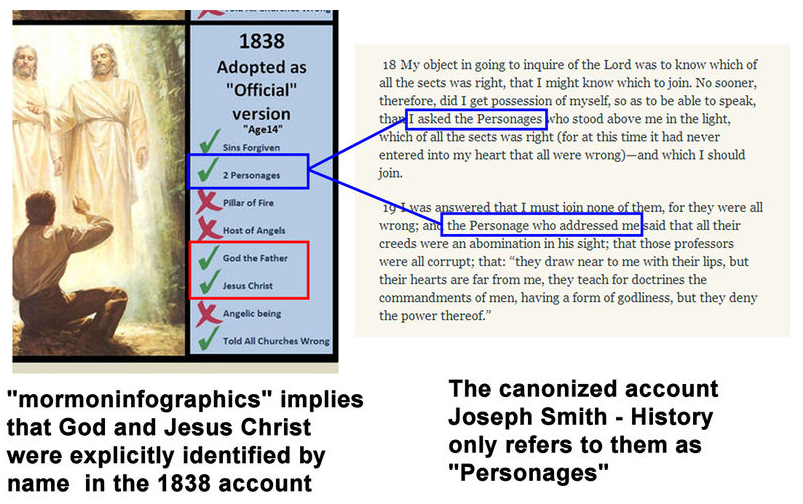
FairMormon deleted their above response. See screenshot.
Jeremy's Response to FairMormon
FairMormon is arguing here that Joseph Smith did not in fact see God the Father and his son Jesus Christ, which is an apostate view given that the recently published LDS.org essay titled “First Vision Accounts” states otherwise:
Joseph Smith recorded that God the Father and Jesus Christ appeared to him…
So, which is it? Did Joseph see God the Father and Jesus Christ or did he merely see two angelic personages?
The graphic states that "pillar of fire" is not mentioned in Joseph's 1832 account
The graphic states that "pillar of fire" is not mentioned in Joseph's 1832 account.
- Joseph wrote “pillar of fire”. He then crossed out the word “fire” and wrote “light.” Therefore Joseph wrote both “pillar of fire” and “pillar of light.”
- Incorrect:
The fact that Joseph decided to write “pillar of light” does not negate the fact that Joseph originally wrote the words “pillar of fire” in his record.
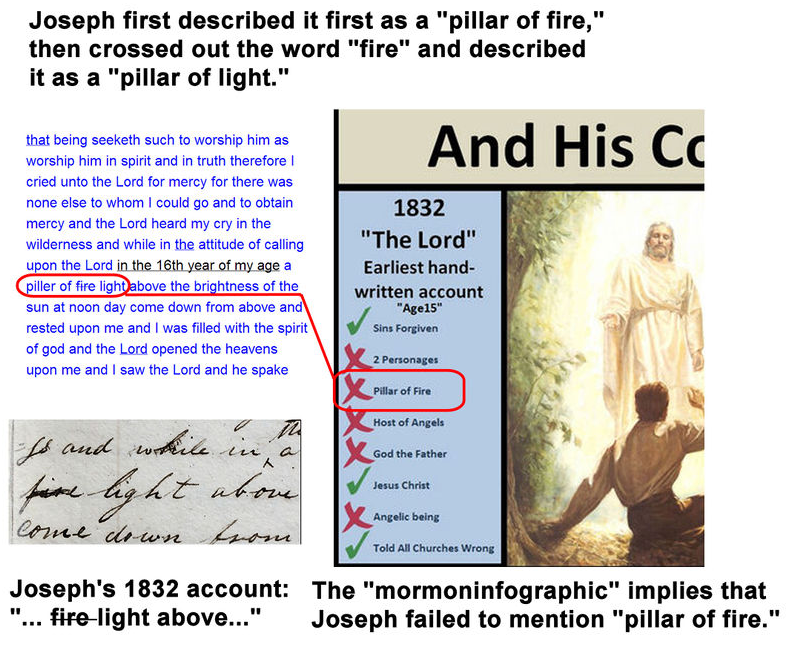
FairMormon deleted their above response. See screenshot.
Jeremy's Response to FairMormon
There is a reason why Joseph crossed out the word “fire” and wrote “light” immediately after it. He intended the wording to be exactly “pillar of light.” If he lived in the age of Microsoft Word and Google Docs, we would have never known that he typed in “fire.” Obviously, Joseph didn’t have the “Delete” button in 1832. Striking out words was the “Delete” button of his time. Joseph’s intention was to remove “fire” off of the record completely.
"The fact that Joseph decided to write ‘pillar of light’ does not negate the fact that Joseph wrote the words ‘pillar of fire’ in his record’."
It does actually. It’s not just the fact that Joseph crossed out the word “fire” but that he actually wrote “light” to replace the word he had just crossed out. By using the “Delete” button of his time along with inserting “light” to immediately replace “fire,” Joseph intended the exact wording to be “pillar of light” – not “pillar of fire.”
It appears that FairMormon is grasping at straws here in their attempt to discredit an otherwise factual infographic visualizing Joseph’s multiple First Vision accounts.
The graphic indicates that the 1835 "Erastus Holmes"
account describes a different vision
The graphic indicates that the 1835 "Erastus Holmes"
account describes a different vision.
- Joseph had described his vision in detail in his journal just five days earlier (9 November 1835) when he described his visit with "Joshua the Jewish Minister." When he described his visit with Erastus Holmes, he simply referred to it as the "first visitation of Angels."
- Incorrect:
The graphic implies that he didn't mention every other element of the vision, and that this makes it inconsistent. However, Joseph was simply offering a one-line summary of the event that he had described only five days earlier in his journal.

FairMormon deleted their above response. See screenshot.
Jeremy's Response to FairMormon
The best case scenario is that Joseph would have recorded exactly what happened when it happened in 1820. Instead, we have to pour over years of journal entries trying to capture what took place. In this summary account, written by Joseph 15 years after the fact, he still manages to directly contradict himself by reporting “visitation of Angels” as compared to an actual visitation from Deity. Those are two starkly different events and that is the point of this infographic and this section; to discuss the conflicting accounts of the First Vision.
The fact that Joseph stated “visitation of Angels” is significant in comparison to all of the other accounts. It is irrelevant whether Joseph gave a full-length description or just a “summary.” If the full-length description or brief summary contradicts the other accounts, we have a problem. In this case? We have a problem.
As mentioned previously, the Church fraudulently altered "visitation of Angels" to "First Vision" when they inserted this account into the History of the Church. Details can be found here.
The author states that "Who appears to him – a spirit, an angel, two angels, Jesus, many angels,
the Father and the Son – are all over the place."
"Who appears to him – a spirit, an angel, two angels, Jesus,
many angels, the Father and the Son – are all over the place."
- Incorrect:
The accounts are not "all over the place" on this issue:
- 1832 Account by Joseph Smith/Frederic G. Williams –
...I saw the Lord - 1835 Account by Joseph Smith (9 Nov. 1835) –
...a personage appeard...another personage soon appeard…and I saw many angels in this vision... - 1835 Account by Joseph Smith (14 Nov. 1835) – (This account is simply a one line summary of the detailed vision written days earlier)
I received the first visitation of Angels which was when I was about 14. - 1838 Account by Joseph Smith (published in 1842) –
I saw two Personages... - 1840 Account by Orson Pratt –
...saw two glorious personages... - 1842 Account by Joseph Smith (Wentworth Letter) –
...saw two glorious personages... - 1842 Account by Orson Hyde –
Two glorious heavenly personages stood before him... - 1843 Account by The Pittsburgh Weekly Gazette –
...then a glorious personage in the light, and then another personage... - 1843 Account by Levi Richards –
...saw two glorious personages... - 1844 Account by Daniel Rupp –
...saw two glorious personages... - 1844 Account by Alexander Neibaur –
saw a personage...a other person came to the side of the first...
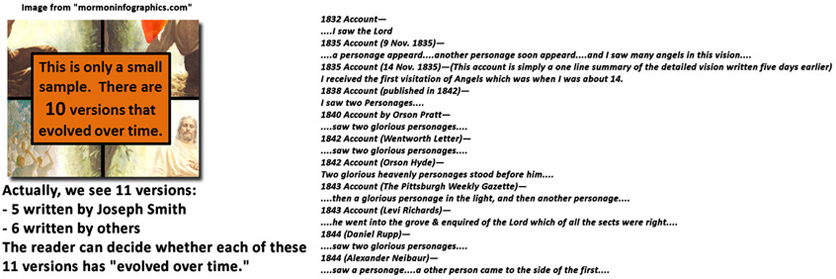
FairMormon deleted their above response. See screenshot.
Jeremy's Response to FairMormon
Yes, we know that Joseph kept his story straight after the 1838 account. It's the earlier accounts that Joseph was inconsistent and even contradictory in.
Why doesn't FairMormon also include the following accounts in their list showing just how “consistent” all of the First Vision accounts are?
Oliver Cowdery:
“In several issues of the LDS periodical Messenger and Advocate (1834–35), Oliver Cowdery wrote an early biography of Joseph Smith, Jr. In one issue, Cowdery explained that Smith was confused by the different religions and local revivals during his ‘15th year’ (1820), leading him to wonder which church was true. In the next issue of the biography, Cowdery explained that reference to Smith's "15th year" was a typographical error, and that actually the revivals and religious confusion took place in Smith's ‘17th year.’
Therefore, according to Cowdery, the religious confusion led Smith to pray in his bedroom, late on the night of September 23, 1823, after the others had gone to sleep, to know which of the competing denominations was correct and whether ‘a Supreme being did exist.’ In response, an angel appeared and granted him forgiveness of his sins. The remainder of the story roughly parallels Smith's later description of a visit by an angel in 1823 who told him about the Golden Plates. Thus, Cowdery's account, containing a single vision, differs from Smith's 1832 account, which contains two separate visions, one in 1821 prompted by religious confusion (the First Vision) and a separate one regarding the plates on September 22, 1822. Cowdery's account also differs from Smith's 1842 account, which includes a First Vision in 1820 and a second vision on September 22, 1823.” – Wikipedia, 1834 account by Oliver Cowdery
You can read a Mormon apologist’s speculative response here.
Brigham Young (Prophet):
“The Lord did not come with the armies of heaven...but He did send his angel to this same obscure person, Joseph Smith jun., who afterwards became a Prophet, Seer, and Revelator, and informed him that he should not join any of the religious sects of the day, for they were all wrong.” – Journal of Discourses, Vol. 2, p.171 (1855)
Wilford Woodruff (Prophet):
“The same organization and Gospel that Christ died for...is again established in this generation. How did it come? By the ministering of an holy angel from God, out of heaven, who held converse with man, and revealed unto him the darkness that enveloped the world...He told him the Gospel was not among men, and that there was not a true organization of His kingdom in the world...Joseph was strengthened by the Spirit and power of God, and was enabled to listen to the teachings of the angel...The man to whom the angel appeared obeyed the Gospel.” – Journal of Discourses, Vol. 2, p.196-197 (1855)
Heber C. Kimball (Apostle):
“Do you suppose that God in person called upon Joseph Smith, our Prophet? God called upon him; but God did not come himself and call, but he sent Peter to do it. Do you not see? He sent Peter and sent Moroni to Joseph, and told him that he had got the plates. Did God come himself? No; he sent Moroni and told him there was a record,…Well, then Peter comes along. Why did not God come? He sent Peter, do you not see? Why did he not come along? Because he has agents to attend to his business, and he sits upon his throne and is established at head-quarters, and tells this man, ‘Go and do this;’ and it is behind the vail just as it is here. You have got to learn that.” – Journal of Discourses, Vol. 6, p.29-30 (1857)
Orson Hyde (Apostle):
“Some one may say, ‘If this work of the last days be true, why did not the Saviour come himself to communicate this intelligence to the world?’ Because to the angels was committed the power of reaping the earth, and it has committed to none else.” – Journal of Discourses, Vol. 6, p.335 (1854)
John Taylor (Prophet):
“How did the state of things called Mormonism originate? We read that an angel came down and revealed himself to Joseph Smith.” – Journal of Discourses, Vol. 10, p.127 (1863)
George A. Smith (Apostle and First Presidency Counselor):
“...he [Joseph Smith] went humbly before the Lord and inquired of Him, and the Lord answered his prayer, and revealed to Joseph, by the ministration of angels, the true condition of the religious world. When the holy angel appeared, Joseph inquired which of all these denominations was right and which he should join, and was told they were all wrong.” – Journal of Discourses, Vol. 12, p.334 (1863)
George A. Smith (Apostle and First Presidency Counselor):
“[Joseph] was enlightened by the vision of an holy angel. When this personage appeared to him, one of the first inquiries was ‘Which of the denominations of Christians in the vicinity was right?’” – Journal of Discourses, Vol. 13, p.78 (1869)
John Taylor:
“None of them was right, just as it was when the Prophet Joseph asked the angel which of the sects was right that he might join it. The answer was that none of them are right.” – Journal of Discourses, Vol. 20, p.167 (1879)
There is absolutely no record of a First Vision prior to 1832
"There is absolutely no record of a First Vision prior to 1832"
- Incorrect:
The word "absolutely" is overstating the case. There is a reference in an 1831 article in the local newspaper, the Palmyra Reflector:
“Book of Mormon.” The Reflector (Palmyra, New York) 2, no. 13 (14 February 1831): 102. BOOK OF MORMON.— Our Painesville correspondent informs us, that about the first of Nov. last, Oliver Cowdery, (we shall notice this character in the course of our labors,) and three others, arrived at that village with the “New Bible,” on a mission to the notorious Sidney Rigdon, who resides in the adjoining town. Rigdon received them graciously— took the book under advisement, and in a few days declared it to be of “Heavenly Origin.” Rigdon, with about 20 of his flock, were dipt immediately. They then proclaimed that there had been no religion in the world for 1500 years,— that no one had been authorised to preach & c. for that period— that Jo Smith had now received a commission from God for that purpose, and that all such as did not submit to his authority, would speedily be destroyed. The world (except the New Jerusalem) would come to an end in two or three years. The state of New- York would (probably) be sunk. Smith (they affirmed), had seen God frequently and personally— Cowdery and his friends had frequent interviews with angels, and had been directed to locate the site for the New Jerusalem, which they should know, the moment they should “step their feet” upon it. They pretend to heal the sick and work miracles, and had made a number of unsuccessful attempts to do so. The Indians were the ten lost tribes— some of them had already been dipt. From 1 to 200 (whites) had already been in the water, and showed great zeal in this new religion— many were converted before they saw the book. Smith was continually receiving new revelations, and it would probably take him 1000 years to complete them— commissions and paper were exhibited, said to be signed by CHRIST himself!!! Cowdery authorised three persons to preach, & c. and descended the Ohio River. The converts are forming “common stock” families, as most pleasing in the sight of God. They pretend to give the “Holy Spirit,” and under its operations they fall upon the floor— see visions, & c. Indians followed Cowdery daily, and finally saw him enter the promised land, where he placed a pole in the ground, with a light on its top, to designate the site of the New Jerusalem. off-site - The newspaper article which reports the missionaries’ teachings refers to “God” twice but also to “Christ” once and the “Holy Spirit” once. Hence, all three members of the Godhead appear to be represented individually in the document. In this context, a natural interpretation demands that “God” refer to the Father and the statement made by the missionaries would therefore mean that sometime before November 1830 ("about the first of Nov last [year]), Joseph Smith had seen God the Father “personally.”
- DC 20:5 contains a reference to the First Vision dated in the 1829-1830 timeframe which is consistent with Joseph's 1832 account:
Section 20
Revelation on Church organization and government, given through Joseph Smith the Prophet, at or near Fayette, New York. Portions of this revelation may have been given as early as summer 1829. The complete revelation, known at the time as the Articles and Covenants, was likely recorded soon after April 6, 1830 (the day the Church was organized). . . . . 5 After it was truly manifested unto this first elder that he had received a remission of his sins, he was entangled again in the vanities of the world; - Quotes to consider
It is also interesting to note that Joseph was talking to others about his vision publicly as early as 1833. The Reverend Richmond Taggart wrote a letter to a ministerial friend, regarding the activities of Joseph Smith himself in Ohio:
The following Curious occurrance occurred last week in Newburg [Ohio] about 6 miles from this Place [Cleveland]. Joe Smith the great Mormonosity was there and held forth, and among other things he told them he had seen Jesus Christ and the Apostles and conversed with them, and that he could perform Miracles. (Richmond Taggart to the Reverend Jonathan Goings, 2 March 1833, 2, Jonathon Goings Papers, American Baptist Historical Society, Rochester, New York, quoted in Dan Vogel (editor), Early Mormon Documents (Salt Lake City, Signature Books, 1996–2003), 5 vols, 1:205.)
FairMormon deleted their above response. See screenshot.
Jeremy's Response to FairMormon
After scouring through everything, the best FairMormon can do is this? This actually confirms the point I’m making in that the First Vision was unknown to the Saints and the world before 1832. In fact, most of the Saints were unaware of a First Vision until it was published in 1842.
I’ll leave it to the reader to decide if “Joe had now received a commission from God” and “Smith (they had affirmed) had seen God frequently and personally” are clear references to Joseph’s First Vision. Many preachers in Joseph’s time and place claimed to have “received a commission from God.”
In 1966, LDS historian James B. Allen (who later became Assistant Church Historian), confirmed that members of the Church during the early years were unaware of the First Vision. He wrote:
According to Joseph Smith, he told the story of the vision immediately after it happened in the early spring of 1820. As a result, he said, he received immediate criticism in the community. There is little if any evidence, however, that by the early 1830’s, Joseph Smith was telling the story in public. At least if he were telling it, no one seemed to consider it important enough to have recorded it at the time, and no one was criticizing him for it…The fact that none of the available contemporary writings about Joseph Smith in the 1830’s, none of the publications of the Church in that decade, and no contemporary journal or correspondence yet discovered mentions the story or the First Vision is convincing evidence that at best it received only limited circulation in those early days…as far as non-Mormons were concerned there was little, if any, awareness of it in 1830’s…
As far as Mormon literature is concerned, there was apparently no reference to Joseph Smith’s First Vision in any published material in the 1830’s…from all this it would appear that the general church membership did not receive information about the First Vision until the 1840’s and that the story certainly did not hold the prominent place in Mormon thought that it does today.
– Dialogue, Autumn 1966, p.30-34
Fawn M. Brodie states:
The description of the vision was first published by Orson Pratt in his Remarkable Visions in 1840, twenty years after it was supposed to have occurred. Between 1820 and 1840 Joseph's friends were writing long panegyrics; his enemies were defaming him in an unceasing stream of affidavits and pamphlets, and Joseph himself was dictating several volumes of Bible-flavored prose. But no one in this long period even intimated that he had heard the story of the two gods. At least, no such intimation has survived in print or manuscript…The first published Mormon history, begun with Joseph's collaboration in 1834 by Oliver Cowdery, ignored it altogether…Joseph's own description of the First Vision was not published until 1842, twenty-two years after the memorable event…
If something happened that spring morning in 1820, it passed totally unnoticed in Joseph's home town, and apparently did not even fix itself in the minds of members of his own family. The awesome vision he described in later years may have been the elaboration of some half-remembered dream stimulated by the early revival excitement and reinforced by the rich folklore of visions circulating in his neighborhood. Or it may have been sheer invention, created some time after 1834 when the need arose for a magnificent tradition to cancel out the stories of his fortune-telling and money-digging. – No Man Knows My History, p.24-25
Despite FairMormon’s attempt to discredit David O. McKay’s niece, the following is what LDS historian and member of the Joseph Smith Papers project, Ronald O. Barney, has to say about Fawn Brodie and her book, No Man Knows My History:
“…her book, is by all accounts, well-written.”
“Fawn Brodie’s claims about Joseph Smith eventually brought censure to her from the Church and she was ‘un-Churched’.”
“There were some attempts to respond to what [Brodie] had to say but they were absent the kind of historical scrutiny that she had applied to the whole milieu of Joseph during his lifetime.”
Respected LDS Scholar and Historian Richard Bushman extensively used No Man Knows My History as a source in his Rough Stone Rolling biography of Joseph Smith.
Joseph Smith claimed much later in his life that he did tell the story at the time, and he claimed that he was bitterly persecuted for doing so. Consider Joseph’s own words:
…all men of high standing would take notice sufficient to excite the public mind against me, and create a bitter persecution; and this was common among all the sects – all united to persecute me…and while they were persecuting me, reviling me, and speaking all manner of evil against me falsely for so saying, I was led to say in my heart: why persecute me for telling the truth?
For something that excited the “public mind against me” and created “a bitter persecution” which were “all united to persecute me…reviling me, and speaking all manner of evil against me…,” where are the records? Newspaper clippings? Witness accounts? Something? Anything? Not even “anti-Mormon” literature record any claims of a First Vision until the 1840s.
The claim of persecution for supposedly discussing the First Vision does not match the culture of the time. In Richard Bushman’s Rough Stone Rolling, he states:
Subjects of revivals all too often claimed to have seen visions. In 1826 a preacher at the Palmyra Academy said he saw Christ descend 'in a glare of brightness, exceeding ten fold the brilliancy of the meridian Sun.' The Wayne Sentinel in 1823 reported Asa Wild’s vision of Christ in Amsterdam, New York, telling him that all denominations were corrupt. At various other times and places, beginning early in the Protestant era, religious eccentrics had claimed visits from divinity. Norris Sterns published an account in 1815 of two beings who appeared to him: ‘One was God, my Maker, almost in bodily shape like a man. His face was, as it were a flame of Fire, and his body, as it had been a Pillar and a Cloud…Below him stood Jesus Christ my Redeemer, in perfect shape like a man. – Rough Stone Rolling, p.41
In 1816 Elias Smith published his vision. After describing a period of soul reflection and anguish, Elias Smith states the following:
"Not long after these things passed through my mind, I went into the woods one morning after a stick of timber; after taking it on my shoulder to bring it to the house, as I walked along on large log that lay above the snow, my foot slipped and I fell partly under the log, the timber fell one end on the log and the other on the snow, and held me, as that I found it difficult at first to rise from the situation I was then in. While in this situation, a light appeared to shine from heaven, not only into my head, but into my heart. This was something very strange to me, and what I had never experienced before. My mind seemed to rise in that light to the throne of God and the Lamb, and while thus gloriously led, what appeared to my understanding was expressed in Rev. xiv. 1. "And I looked, and, lo, a Lamb stood on the mount Sion, and with him an hundred forty and four thousand, having his Father's name written in their foreheads." The Lamb once slain appeared to my understanding, and while viewing him, I felt such love to him as I never felt to any thing earthly. My mind was calm and at peace with God through the Lamb of God, that taketh away the sin of the world. The view of the Lamb on mount Sion gave my joy unspeakable and full of glory. It is not possible for me to tell how long I remained in that situation, as every thing earthly was gone from me for some time."
– The Life, Conversion, Preaching, Travels, and Sufferings of Elias Smith, p.58
Other Vision Claims
Joseph Smith's theophany, or First Vision account, was not unprecedented or unique. There were numerous accounts by individuals claiming to have had visions or encounters with God in the years prior to and contemporary with Joseph Smith's account. Some of these accounts bear a remarkable similarity with the descriptions that Joseph Smith provided - in some cases using similar descriptive terms and phrases. LDS historian and scholar Richard Bushman has identified over 33 visions that other individuals claimed to have between 1782 and 1815 in his The Visionary World of Joseph Smith found at BYU Studies.
The dates posted are the dates at which the accounts would have possibly been available to Joseph Smith in the Palmyra NY area. The actual dates that the various authors state their visions occurred on may be discovered by reading the source texts.
- 1786 Catharine Hummer -
Catharine Hummer was the daughter of a respected German Baptist preacher in Pennsylvania. She described several visions occurring between 1762 and 1765. She traveled with her father and drew people from all around the York County PA region. While Joseph did not likely encounter her experience in print, it is possible that he heard depictions of it through word of mouth. In any event, the account of Catharine Hummer demonstrates that visions of God the father and Jesus Christ as two separate beings were not unprecedented.
"...and looking about I saw an angel standing at my right hand, who said: "Yes, my friend, it is midnight and late; the hour of midnight is approaching; alas, what shall I sav? love has grown cool among the members. Oh, that this were not so among those who are Brethren in the faith!" ... And the Saviour and the Father stood on the other side of the water, and the Saviour called the innocent by name, one after the other, to go in. ...These two, the Father and the Son, stood together on the other side. Then they also came to the water and preached, the Father to the godless, the Son to the pious."
Chronicon Ephratense, pp.268-276
- 1794 Richard Brothers -
Richard brothers was British religious fanatic and early believer and teacher of Anglo-Israelism - the idea that those of anglo-european descent (particularly the british) were the remnant of the lost tribes of Israel. In 1793 Brothers founded a new religion with himself as Apostle. He published an account of a vision and theophany in 1794.
"I was, to prepare me for the designation of God, carried up to heaven . in a vision, and saw on my right side at a small distance, a beautiful silver white bird in the shape of a Dove, but a little larger; it was the HOLY GHOST, and was the very same that descended on the head of my BLESSED SAVIOUR, when he came up from being baptized in the river Jordan ; he kept between me and Satan who was then revealed that I might witness it and great power given him to visit the Earth, The LORD GOD then spoke to me from the middle of a white shining cloud...
...I was in a Vision and being carried up to heaven the Lord God spoke to me from the middle of a large white cloud, and said in a strong clear voice—-ALL, ALL I pardon London, and all the people in it, for your sake : there is no other man On earth that could stand before me to ask for so great a thing. " Richard Brothers, 1794, pp. 29-30
It is notable that Brothers, Like Joseph Smith, claimed a divine calling which included a commandment to bring forth revealed knowledge, establishment of a new religion and apostleship.
- 1812 David Brainerd -
In 1812 David Brainerd's journal was published, including an account of his own theophany, in which he describes an encounter with God. His encounter is similar to Joseph Smith's in that it took place in a grove after much spiritual distress, however Brainerd's description of God is not anthropomorphic:
“...as I was walking in a dark thick grove unspeakable glory seemed to open to the view of my soul: I do not mean any external brightness, nor any imagination of a body of light, or any thing of that nature; but it was a new inward apprehension, or view that I had of God, such as I never had before. I stood still, and admired. I knew that I had never seen before any thing comparable to it for excellency and beauty; it was widely different from all the conceptions that ever I had of God, or things divine. I had no particular apprehension of any one person in the Trinity, either the Father, the Son, or the Holy Ghost; but it appeared to be divine glory that I then beheld: and my soul rejoiced with joy unspeakable to see such a glorious divine Being; and I was inwardly pleased and satisfied that he should be God over all for ever and ever..” The Life Of David Brainerd, 1812, p.23
- 1813 Benjamin Abbott -
Rev. Benjamin Abbott published an account of his 1772 vision in 1813. His vision included seeing both God the Father ("Ancient of Days") and Jesus Christ, as well as a pronouncement that his sins were forgiven:
" ...at that instant I awoke, and saw by faith the Lord Jesus Christ standing by me, with his arms extended wide, saying to me, "I died for you." I then looked up, and by faith I saw the Ancient of Days, and he said to me, "I freely forgive thee for what Christ has done." At this I burst into a flood of tears, and with joy in my heart cried and praised God, and said, Oh! that there were a minister to give me the Lord's Supper! Then by faith I saw the Lord Jesus come to me as with a cup in his hand, and he gave it me, and I took it and drank thereof ; It was like unto honey for sweetness. At that moment the scriptures were wonderfully opened to my understanding." The Experience, and Gospel Labours, of the Rev. Benjamin Abbott p. 20
Rev. Abbott also recounts persecution he experienced as a result of sharing his visionary experience with a Presbyterian minister:
A few days after, an elder of the presbyterian meeting came to talk with me, to whom I told my experience ; and that I knew that God, for Christ's sake, had forgiven my sins. He replied, that he had been a member of the church twenty-five years, and never before heard any one say that "he knew his sins were forgiven; and for any one to say that he knew his sins were forgiven, he ought to be burnt; for he made himself as perfect as an angel in heaven: nay, said he, I would help to burn such a man myself." The Experience, and Gospel Labours, of the Rev. Benjamin Abbott p. 31
- 1814 Lorenzo Dow -
Lorenzo Dow (October 16, 1777 – February 2, 1834) was an eccentric American preacher, said to have preached to more people than any other preacher of his era. His compiled journal was published in 1814, containing an account of his own heavenly theophany while a young teen boy:
"When past the age of thirteen years... I went out of doors, and was taken up by a whirlwind and carried above the skies : at length I discovered, across a gulph as it were through a mist of darkness, a glorious place, in which was a throne of ivory overlaid with gold, and God sitting upon it, and Jesus Christ at his right hand, and angels, and glorified spirits, celebrating praise — Oh ! the joyful music !" Journal of Lorenzo Dow (1814)
This account is notable for the age of the experience as well as the presentation of God and Jesus as two separate beings.
- 1815 Norris Stearns -
Norris Stearns in 1815 published his own vision in Greenfield, Massachusetts --- not far from where the Joseph Smith Senior family lived in Vermont.
"At length, as I lay apparently upon the brink of eternal woe, seeing nothing but death before me, suddenly there came a sweet flow of the love of God to my soul, which gradually increased. At the same time, there appeared a small gleam of light in the room, above the brightness of the sun, then at his meridian, which grew brighter and brighter: As this light and love increased, my sins began to separate, and the Mountain removed towards the east. At length, being in an ecstasy of joy, I turned to the other side of the bed, (whether in the body or out I cannot tell, God knoweth) there I saw two spirits, which I knew at the first sight. But if I had the tongue of an Angel I could not describe their glory, for they brought the joys of heaven with them. One was God, my Maker, almost in bodily shape like a man. His face was, as it were a flame of Fire, and his body, as it had been a Pillar and a Cloud. In looking steadfastly to discern features, I could see none, but a small glimpse would appear in some other place. Below him stood Jesus Christ my Redeemer, in perfect shape like a man—His face was not ablaze, but had the countenance of fire, being bright and shining. His Father’s will appeared to be his! All was condescension, peace, and love!!" The Religious Experience Of Norris Stearns Written by Divine Command (1815)
The most intriguing aspect of Stearns' "vision," is how he described the Father and the Son as two separate, distinct, human personages. LDS faithful have long considered that that was one of the "truths" that had been lost from the world until Joseph Smith's First Vision.
- 1821 Charles G. Finney -

Charles Finney was a lawyer turned christian revivalist who described a theophany experience with many parallels to Joseph Smith's First Vision. He describes retiring to the woods to pray, being unable to speak, the sensation of footsteps of someone approaching, being seized upon by a wickedness, and later seeing Christ face to face. His full account is lengthy and may be viewed in it's published form at archive.org.
Here is a comparison of key features in the descriptions:
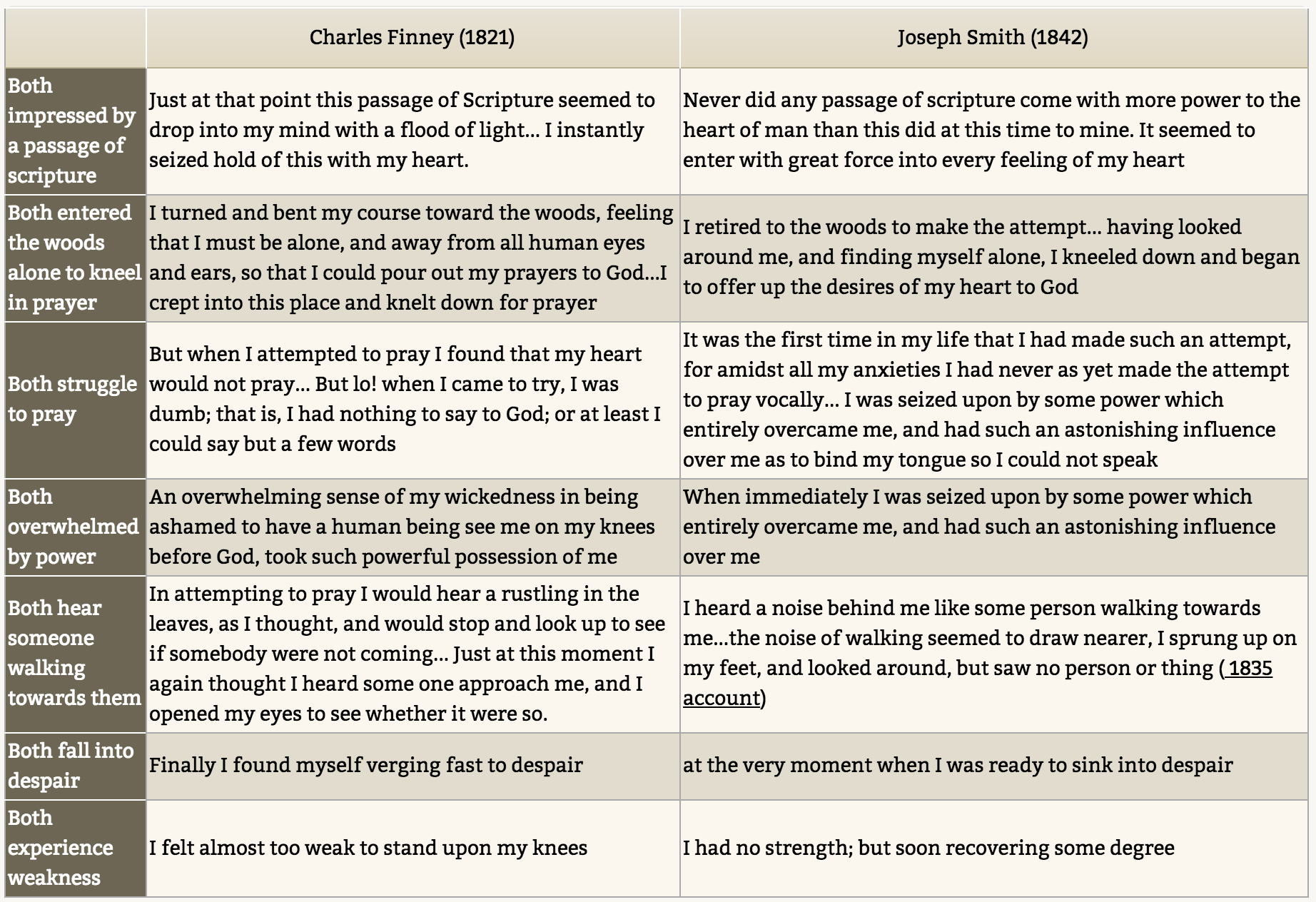
- 1821 Benjamin Putnam -
Benjamin Putnam of Topsham, Vermont, wrote of a distant revival of religion which impressed his family when he was thirteen years of age. He describes a vision on January 14, 1802,
“I had never as yet attempted to pray . . . I instantly had a view as I thought, of the Lord Jesus Christ with his arms extended in an inviting posture—and at the same time this passage of scripture came forcibly to my mind as though he spoke it, ‘Suffer little children, and forbid them not, to come unto me, for of such is the kingdom of heaven.’” Benjamin Putnam [b. 1788], A Sketch of the Life of Elder Benj. Putnam, pp. 15-19
- 1823 Asa Wild -
This account of heavenly communication was published in 1823 in the Wayne Sentinel - the local paper for Palmyra NY.
"the Lord in his boundless goodness was pleased to communicate the following Revelation, having in the first place presented me with a very glorious Vision, in which I saw the same things: In the first place I observe that my mind had been brought into the most profound stillness, and awe; realizing in a remarkable manner the majesty, greatness and glory, of that Being before whom all nations are as the drop of the bucket. It seemed as if my mind, though active in its very nature, had lost all its activity, and was struck motionless, as well as into nothing, before the awful and glorious majesty of the Great Jehovah. He then spake to the following ourport; and in such a manner as I could not describe if I should attempt..." "A Short Sketch of the Religious Experience and Spiritual Travels of Asa Wild, of Amsterdam, N.Y." excerpt printed in Wayne Sentinel, Palmyra, N. Y., Wednesday, October 22, 1823
The account goes on to declare that "the Millennium state of the world is about to take place; that in seven years literally, there would scarce a sinner be found on earth; that the earth itself, as well as the souls and bodies of its inhabitants, should be redeemed, as before the fall, and become as the garden of Eden." - an event which did not take place.
Additionally, this account is sometimes cited by LDS leaders due to it's condemnation of the Christian sects "He also told me, that every denomination of professing christians had become extremely corrupt;" and it's declaration that God was "now raising up, that class of persons ... having the everlasting gospel to preach, that these persons are of an inferior [social] class, and small learning; that they were rejected by every denomination as a body; but soon, God will open their way, by miracles, judgments, &c. that they will have higher authority, greater power, superior inspiration, and a greater degree of holiness than was ever experienced before" This is seen as a prophetic prediction of the coming of Joseph Smith.
- 1824 Alexander Campbell (2nd hand) -
Alexander Campbell wrote the following on March 1, 1824, concerning a "revival in the state of New York":
"Enthusiasm flourishes.... This man was regenerated when asleep, by a vision of the night. That man heard a voice in the woods, saying, 'Thy sins be forgiven thee.' A third saw his Savior descending to the tops of the trees at noon day" The Christian Baptist, Vol. 1, pp.148-49
This account mirrors the location of the vision (woods) as well as having sins forgiven and Christ descending to the tops of trees.
- 1825 Billy Hibbard -
New York preacher Billy Hibbard published his memoirs in 1825 and included a theophany experience from when he was a young boy of 11:
"...when I came to the place of prayer, had kneeled down and closed my eyes, with my hands uplifted toward the heavens, I saw Jesus Christ at the right hand of God looking down upon me, and God the Father looking upon him. The look of Jesus on me removed the burden of my sins, while he spoke these words, " Be faithful unto death and this shall be thy place of rest." Memoirs of the Life and Travels of B. Hibbard: Minister of the Gospel
His story is notable for a depiction of God and Jesus Christ as separate beings as well as having had his sins forgiven him as part of the vision.
- 1826 John S Thompson -
John S Thompson, a New York universalist minister, published a theophany account in 1826:
“I dreamed Christ descended from the firmament, in a glare of brightness, exceeding ten fold the brilliancy of the meridian Sun, and he came to me saying, ‘I commission you to go and tell mankind that I am come; and bid every man to shout victory.” The Christian Guide to a Right Understanding of the Sacred Scriptures, John S Thompson, 1826 p. 71
This account is notable for Christ descending from the heavens, the description of the brightness of Christ being greater than the sun and the pronouncement of a divine commission.
- 1829 Solomon Chamberlain -
An account recorded in John Taylor Nauvoo Journal expands upon the experiences of Solomon Chamberlain who describes a heavenly vision occurring in 1816. Solomon had experienced a number of visions which he detailed in a 1929 pamphlet. In his journeys he spent time with numerous religious sects, ending up finally among the Mormons in 1829 where he found harmony with his own revelatory experience. He introduced himself to the Smith household by way of sharing his visionary account and was baptized by Joseph Smith.
While his pamphlet does not detail his original 1816 vision and theophany, he provided greater detail to John Taylor which is recorded in Taylor's Nauvoo journal. It is presumed that he shared this story with the Smith family at their initial encounter.
"The Lord revealed to me in a vision of the night an angel, I thought if I could ask him, he could tell me all I wanted to know. I accordingly asked him if we were right. He said not one of us were right, and that there were no people on earth that were right; but that the Lord would in his own due time raise up a church, different from all others, and he would give power and authority as in the days of Christ; and he would carry it through, and it should never be confounded; and that I should live to see the day, and know the work when it came forth; and that great persecution should follow, and much more after this he told me. I proclaimed it to the world and all people what I had seen and heard; and that all denominations on earth were as John said constituted the great whore of all the earth." John Taylor Nauvoo Journal
Solomon also included a description of this experience in his 1858 autobiography:
"About this time the Lord showed me in a vision, that there were no people on the earth that were right, and that faith was gone from the earth, excepting a few and that all churches were corrupt. I further saw in vision, that he would soon raise up a church, that would be after the Apostolic Order, that there would be in it the same powers, and gifts that were in the days of Christ, and that I should live to see the day, and that there would a book come forth, like unto the Bible and the people would [be] guided by it, as well as the Bible. This was in the year of 1816. I then believed in gifts and miracles as the Latter-day Saints do, for which I was much persecuted and called deluded. This vision I received from an angel or spirit from the eternal world that told me these things." - Autobiography of Solomon Chamberlain
It is noted that Solomon's initial presentation of his experiences to Joseph Smith predates any first or second hand record of Joseph Smith's own First Vision account.
- 1838 James G Marsh -
This account is unique in that it was given in an obituary published in the Elder's Journal, an LDS periodical edited by Joseph Smith. It included the fact that James Marsh was 14 years old at the time of his death and that he had experienced a remarkable vision - speaking with God, the Father face-to-face.
OBITUARY. DIED on the 7th of May last, James G. Marsh, second son of Thomas B. Marsh, aged 14 years, 11 months and seven days.From early infancy he manifested a love and reverence towards his Heavenly Father, while his parents diligently taught him the first principles of the gospel of Jesus Christ. And having a thirst for knowledge and a love of good principles, he eagerly embraced the gospel, and was baptized into the Church of Jesus Christ of latter day saints, early in the spring of 1832, being between eight and nine years of age.
His great love of knowledge led him to take hold of every opportunity to read the most useful books, and as he was a lover of the gospel, he made himself well acquainted with the sacred writings, and even at this early age, he had become well skilled in profane as well as sacred history.
It seems that the Lord had respect unto this lover of righteousness, for when he was but about nine years of age, he had a remarkable vision, in which he talked with the Father and many of the ancient prophets face to face, and beheld the Son of God coming in his glory...” James G. Marsh Obituary
While Joseph Smith had disclosed his own theophany prior to this in a private discussion with Erastus Holmes in 1835, he had not yet published his story at the time of this obituary.
- 1841 Emanuel Swedenborg -
Taken from a swedish account by a close friend, Christian theologian Emanuel Swedenborg relates his visitation from God. This account was first published in english available to the americas in 1841.
'The following night the same Man appeared to me again. I was this time not at all alarmed. The Man said — ' I am God, the Lord, the Creator, and Redeemer of the World. I have chosen thee to unfold to men the Spiritual Sense of the Holy Scripture. I will myself dictate to thee what thou shalt write.' ' The same night the World of Spirits, Hell and Heaven, were convincingly opened to me, where I found many persons of my acquaintance of all conditions. From that day forth I gave up all worldly learning, and laboured only in spiritual things, according to what the Lord commanded me to write. Thereafter the Lord daily opened the eyes of my Spirit to see in perfect wakefulness what was going on in the other World, and to converse, broad awake, with Angels and Spirits.'
The account is notable for the anthropomorphic depiction of God as well as a declaration of the visionary as one who is specially chosen to receive and write God's words.
In the 1832 account, Joseph said that before
praying he knew that there was no true or living
faith or denomination upon the earth
"In the 1832 account, Joseph said that before praying he knew that there was no true or living faith or denomination upon the earth as built by Jesus Christ in the New Testament. His primary purpose in going to prayer was to seek forgiveness of his sins...In the official 1838 account, Joseph said his “object in going to inquire of the Lord was to know which of all the sects was right, that I might know which to join"...”(for at this time it had never entered into my heart that all were wrong)”.This is in direct contradiction to his 1832 First Vision account."
- Actually, Joseph's motivation in his 1832 account, in addition to seeking forgiveness of his sins, was also to determine whether God's church was upon the earth.
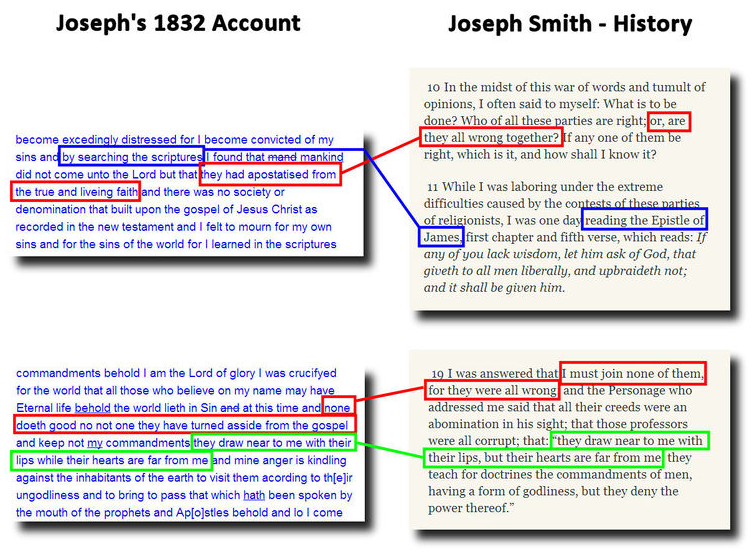
FairMormon deleted their above response. See screenshot.
Jeremy's Response to FairMormon
FairMormon is being deceptive here by once again omitting the following glaring contradiction from their readers:
1832 handwritten account by Joseph Smith:


Official 1838 First Vision account:

Conclusion
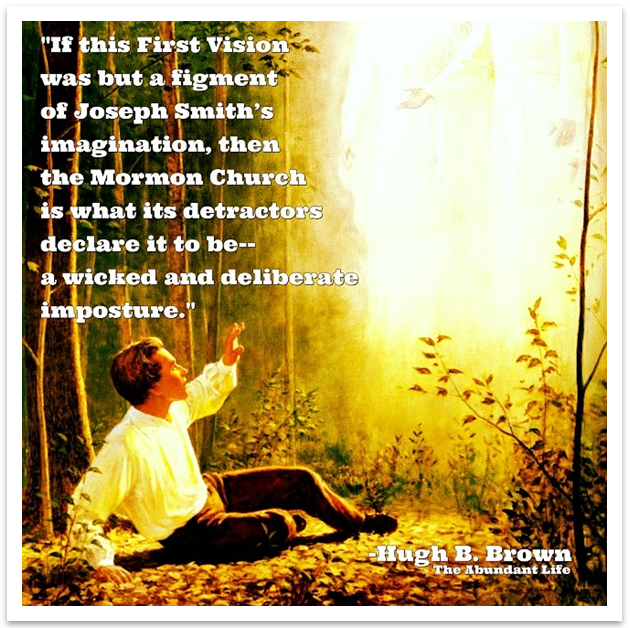
I’m going to conclude this section with the very fascinating and comprehensive “Joseph Smith's changing view of God as seen in his First Vision accounts” November 2013 lecture by former CES Institute Director of 34 years and LDS historian Grant Palmer. He goes over the different First Vision accounts and its contradictions and issues.
One fascinating story out of several shared by Grant Palmer is future prophet Joseph Fielding Smith discovering the 1832 First Vision handwritten account in Joseph’s letter book. Joseph Fielding Smith, upon discovering the 1832 account, ripped out the pages out of the letter book. He then took the ripped documents and hid them in his personal safe where they were hidden out of circulation for three decades until the mid-1960s. Upon learning that Church enemies, Jerald and Sandra Tanner, were aware of these documents, Joseph Fielding Smith removed the documents out of his personal safe and had them taped back into Joseph’s letter book that he removed decades earlier.
(Starts @ 01:51)
Outline mentioned in the lecture can be found here.












